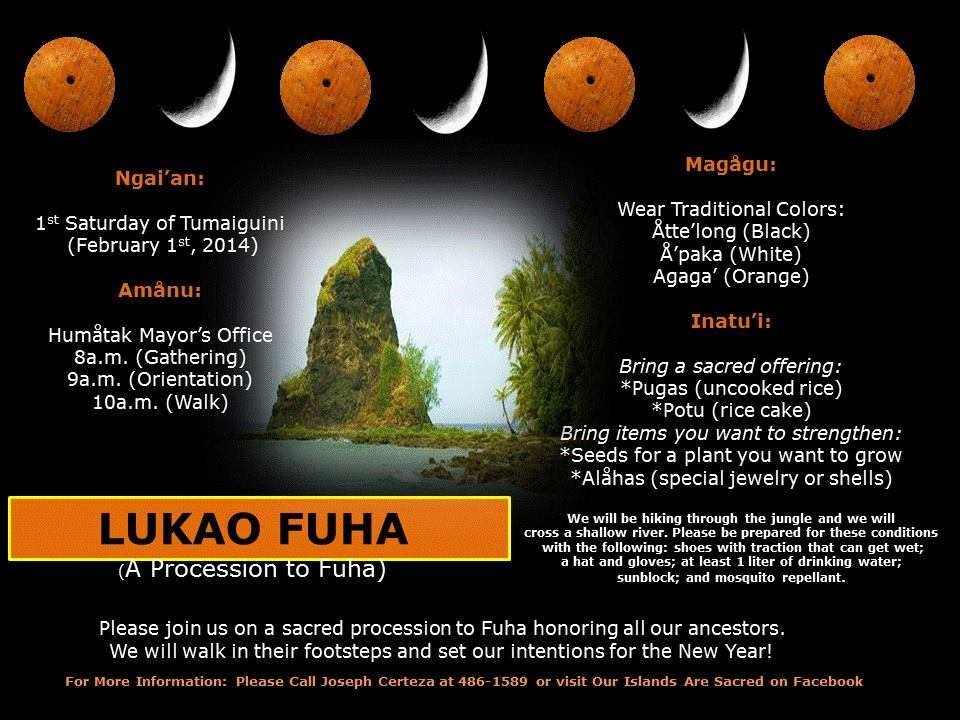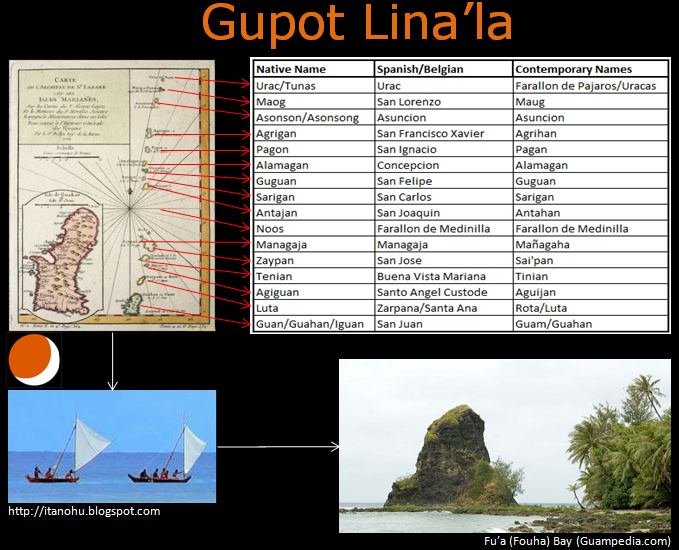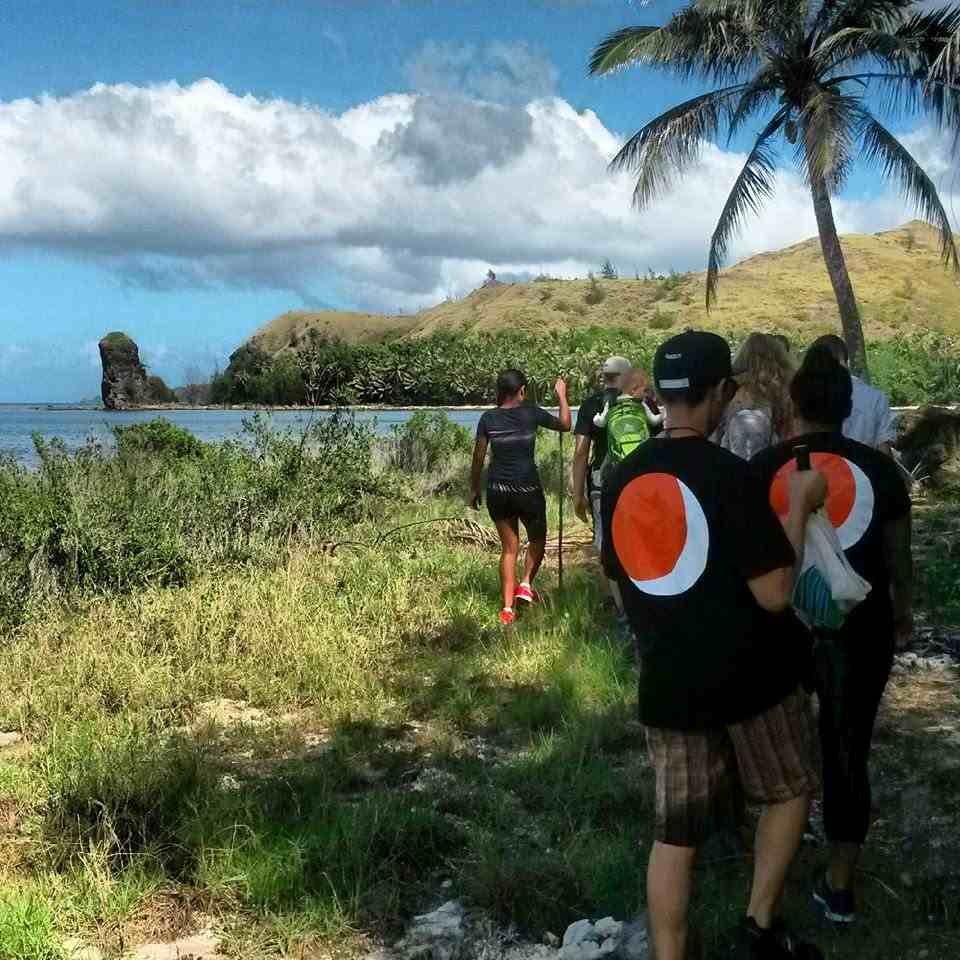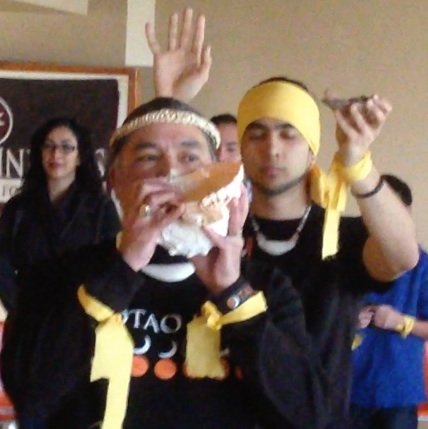Lukao Fuha

Some of you already may have known about this or even participated in the celebration of this historic revived ancient tradition of celebrating the Taotao Håya (Chamorro) new year. To me it was very enlightening and I just can't help myself but to write and talk more about it. Telling the story over and over was the way of our ancestors conveying our heritage and history; generation after generation.
The event was Lukao Fuha or a procession to Fouha Rock in Fouha Bay. Fouha Bay was a very sacred place in Ancient times for Chamorros. "It was so sacred that the Spanish accounts even recognize its religious significance. This is important because the priests were committed to doing away with most of the religion of Ancient Chamorros and finding ways to subvert it and make it become subordinate to the new Catholic faith. But Fouha Bay in Umatac was noted for being a place where Chamorros from villages around the entire island would travel to hold a ceremony or gathering to honor Fu'una and Puntan, who according to the priests were the great beings that Chamorros honored as their creators." (Bevacqua, 2014)

 "Each year our Taotao Håya celebrated the birth of life emanating from the stories of Fo'na (Fu'una) yan Pontan (Puntan). Great preparations were made for any celebrated event. And in this particular event, families from all the islands would be represented to make their way down to Guam to participate in the celebration of Fo'na yan Pontan, and the games of competition that would ensue." (Punzalan, 2014)
"Each year our Taotao Håya celebrated the birth of life emanating from the stories of Fo'na (Fu'una) yan Pontan (Puntan). Great preparations were made for any celebrated event. And in this particular event, families from all the islands would be represented to make their way down to Guam to participate in the celebration of Fo'na yan Pontan, and the games of competition that would ensue." (Punzalan, 2014)
So on February 1, 2014 many people on Guam participated in the procession, orgranized by the groups Our Islands Are Sacred and Hinasso to celebrate the Chamorro New Year and in honor of our ancestors.
Pina'ok Tumaiguini
Also on February 1, 2014 (Pacific Standard Time), approximately 30 descendants of Taotao Håya, and some invited guests, in Washington State made a journey to meet, gather and celebrate the Lunar New Year in honor of a once dormant ancient tradition performed by our ancestors. The gathering was held at the Daybreak Star Cultural Center, Seattle, which is located on unceded Duwamish land. My family and I took part in this intimate celebrated event that we called Pina'ok Tumaiguini.
Pina'ok is to celebrate. Tumaiguini means, "to become like this," and is also the first seasonal moon (month) of the Taotao Håya New Year (consists of 13 lunar months).
 The event was beautifully led and organized by Dåko'ta Alcantara-Camacho. At the event, there was a cultural display provided by Noel Borja Quitugua. The event included welcoming remarks, annointment of coconut oil on all participants, some history, a talk by Richard (Native American), and some chants. I had the blessed honor to sound the Kulo!
The event was beautifully led and organized by Dåko'ta Alcantara-Camacho. At the event, there was a cultural display provided by Noel Borja Quitugua. The event included welcoming remarks, annointment of coconut oil on all participants, some history, a talk by Richard (Native American), and some chants. I had the blessed honor to sound the Kulo!
It was a very uplifting ceremony that I am honored to have participated in and to have shared some of my thoughts with those in attendance. I am proud of the younger generation for leading and taking on this revived ancient tradition of our ancestors.
I have provided some pictures and a couple of videos of Pina'ok Tumaiguini. It is my hope that many others abroad would join in and celebrate this revived ancient tradition of our ancestors. Fan Magof Hamyu Taotao Håya!
Gi Tinituhon
Finakpo
Sources:
- Michael Bevacqua. 2014. Lukao Fuha. Retrieved February 2, 2014 from: http://minagahet.blogspot.com/2014/02/lukao-fuha.html
- Father Peter Coomans. 2000. History of the Mission in the Mariana Islands: 1667-1673, translated and edited by Rodrigue Levesque. Northern Mariana Islands, Division of Historic Preservation: Saipan
- Celeste Perez, ' Fu'una', referenced December 2, 2013, © 2009 Guampedia™, URL: http://guampedia.com/fuuna/
- Bernard Punzalan. 2014. Gupot Lina'la. Retrieved February 2, 2014 from: https://www.facebook.com/hinasso/photos/pb.193309457499884.-2207520000.1391618389./241523389345157/?type=3&theater
- Marcelo Ridabdeneira. 1977. The Account of a Discalced Friar's Stay in the Islands of the Ladrones, translated by Marjorie G. Driver. Guam Recorder Volume 7, pg. 19-21.

